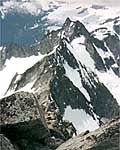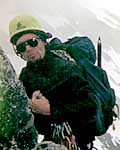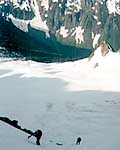
Back to the Pub
Check Out:
Marketplace
Climbing Home
Contest
Auctions
Expedition News

Lesson on Forbidden Peak
People: Tim Godfrey, Joel Meyers, Sean Smith, Spencer Reeder
 Forbidden Peak [Click to Zoom] (photo: J. Meyers) |
| "Two wet, heavy, 60 meter climbing ropes tied together, twisting through alpine routes of snow and rock, just love to get stuck..." |
Joel, Spencer, Sean, and myself parked on Cascade River road, three miles before the trailhead and hiked up the climbers trail arriving at Boston Basin in about five hours. We camped at an established area called Lower Camp on a rock outcropping at the edge of treeline.
 Time for a snack [Click to Zoom] (photo: S. Reeder) |
The climbing was moderate, 5.6 to 5.7 on good quality rock. The exposure was exhilarating and the scenery breathtaking. We decided to do fixed belays on all the pitches which ultimately slowed us down considerably. The weather was nearly perfect until nearing the summit when the clouds moved in all around us. We knew the descent was going to be difficult and time consuming so we set a turn around time of 1:30pm.
At 2pm, Joel reached the summit, with Spencer belaying him. Sean and I were right behind and we decided to call it good and turn around as we had already passed our turn around time. It was difficult to turn around one pitch before the summit, but we agreed to stick to the plan and felt that for all intents and purposes, we had made it.
 Beginning the Couloir [Click to Zoom] (photo: J. Meyers) |
We began our descent, following the climbing route with our options having been to downclimb or rappel. The rappels were awkward and indirect, but we thought they would be more efficient. They weren't. It became a time consuming, troublesome effort. The rope got stuck twice while pulling down the rappel, including once when I had to climb back up to free it. Finally we switched back into two person teams and descended the route downclimbing — a better choice. We reached the top of the couloir at around 5:30pm. (I'm guessing on the time and will be from here on out it all becomes a blur.)
Looking down the couloir and the soft, crappy condition of the snow, we knew we were in for a real challenge. We could not safely downclimb the couloir because a misstep could set off a slide and/or if we slipped and went down the couloir, it probably would have been a death fall. We found some rap slings near the top of the couloir and set up a double rope rappel.
Joel descended into the couloir and found a rap station with old slings in a narrow gully between the rock and snow. We all descended to there, reinforced the rap station and attempted to pull the rope from the previous rappel. The rope was stuck. After fruitless attempts to free it, Joel climbed back up the couloir, tying "bites" on rappel until he was at another rappel station (one we had skipped because we had double ropes), from which he could successfully free and pull the rope. Time was burning away and darkness was quickly approaching. I rappelled down the gully hoping to find another rap station and planning to make one if nothing turned up. As light faded, I saw two slings on a horn about 15 feet up the rock wall on the opposite side of the gully. Awkwardly, I found my way up to the slings, got safe, and the rest of the group headed down.
The slings here were old and questionable, so I replaced them with new ones. By now it was completely dark and the moon was up though partially obscured by clouds. We were near the mouth of the couloir, in complete darkness, still at a dangerous section of snow just above the bergshrund. We tried to pull the rope for the start of the hopefully final rappel and, once again, it became jammed.
Two wet, heavy, 60 meter climbing ropes tied together, twisting through alpine routes of snow and rock just love to get stuck. Sean volunteered to ascend on rappel and free the rope (big kudos to Sean here). Despite being very exhausted he hauled himself up the rope, up a chimney, and set a new rappel from which we could pull the rope. We all sat on the side of the couloir in a five foot space between the rock and snow, with ample refrigeration for over an hour-and-a-half.
Finally we rappelled down onto a steep section of the glacier, leaving behind a bit of gear at an improvised rap station. We pulled out our ice axes, all four tied together on the rope, and we descended the glacier towards base camp. At 4am, we passed a two-person team coming up the glacier (they began their climb at 2am). We arrived back at base camp around 5:30am, 24 hours after beginning our climb.
We descended into our sleeping bags for a three hour nap before packing up and leaving around noon. While it was quite an epic, I, for one, learned a lot about doing that type of mixed alpine route. Our first mistake was underestimating the climb and how long it would take. I would begin much earlier if I had it to do again. Secondly, to be time efficient on mid-class 5 rock, the key is to move as completely independent two person teams, simul-climbing and using running belays wherever needed.
On the descent, I would downclimb if the rappel isn't clean or obvious, so long as it can be downclimbed with relative safety. Again remain in two independent teams (all four of us tried to do double rope rappels). In the future, I will do double rope rappels only where I am sure they will save time. In our case, the longer rope, the time to set it up correctly and the problem with the knot getting stuck, wasted too much time for it to be worthwhile. I am not sure what I would have done differently on the descent in the couloir except to have given ourselves enough time to do it during the daylight and, again, only use the double rope rappel where absolutely necessary.
Finally, never, as we did, underestimate the commitment of any alpine route, especially if it does not have the reputation of a big mountain like Rainier.
Though it was an arduous adventure and we didn't make perfect choices, I was confident in our team and feel we all did really well. Indeed we were stressed, grumpy and a bit short with each other at times, but that was to be expected. We kept our wits about us, stayed focused, worked as a team and did what was needed to make it down safely. Overall, it was a valuable learning experience for me and I do not regret at all having done the climb. I look forward to trying it again sometime with more knowledge.
— Tim Godfrey, Mountain Zone Pubster
